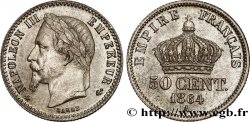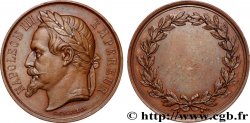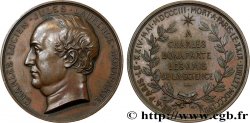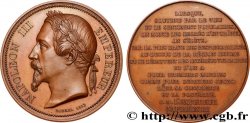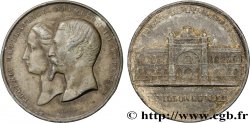fme_1020510 - SECOND EMPIRE Médaille, Palais de l’Industrie, pavillon du nord
40.00 €约 333.60 CNY
数量
加入购物车

种类 Médaille, Palais de l’Industrie, pavillon du nord
日期: 1855
铸币厂名称/城市 75 - Paris
材质 zinc
直径 50,5 mm
模子方针 12 h.
硬币制模工 CAQUÉ Armand Auguste (1795-1881) / WIENER Jacques (1813-)
重量 51?13 g.
侧面 lisse + main ZINC
印模 main ZINC
关于品相的说明
Taches d’oxydation et concrétions, notamment au revers
正面
正面的文字 EUGENIE IMPERATRICE - NAPOLEON III EMPEREUR.
正面的说明书 Têtes d’Eugénie et de Napoléon III à gauche. Signé : CAQUE F. / GRAVEUR DE S. M. L’EMPEREUR.
背面
背面的文字 PALAIS DE L’INDUSTRIE // PAVILLON DU NORD.
背面的说明书 Vue du Palais de l’Industrie, façade Nord. Signé : GERVAIS ET C EDIT..
评论
Diverses médailles commémorent l’édification de ce Palais de l’Industrie. Il est possible de retrouver trois diamètres différents : 68mm, 50mm et 36mm.
Le Palais de l'Industrie et des Beaux-arts, ou plus communément Palais de l'Industrie, est un édifice construit pour l'Exposition universelle de 1855 sur les Champs-Élysées à Paris. Il est l'œuvre de l'architecte Victor Viel et de l'ingénieur Alexis Barrault. Il est détruit à partir de 1896 pour laisser place au Petit Palais et au Grand Palais. Inauguré le 15 mai 1855 par Louis-Napoléon Bonaparte, récemment devenu l'empereur Napoléon III, il fut l'emblème de la première Exposition universelle française. Cette Exposition, qui attira plus de cinq millions de visiteurs, fut la réponse du chef de l'État français au succès de l'Exposition universelle de 1851 de Londres, célébrée notamment pour l'audace et la nouveauté de son Crystal Palace.
Various medals commemorate the construction of this Palace of Industry. It is possible to find three different diameters: 68mm, 50mm and 36mm. The Palace of Industry and Fine Arts, or more commonly the Palace of Industry, is a building constructed for the 1855 Universal Exhibition on the Champs-Élysées in Paris. It is the work of the architect Victor Viel and the engineer Alexis Barrault. It was demolished in 1896 to make way for the Petit Palais and the Grand Palais. Inaugurated on May 15, 1855 by Louis-Napoléon Bonaparte, recently become Emperor Napoleon III, it was the emblem of the first French Universal Exhibition. This Exhibition, which attracted more than five million visitors, was the response of the French head of state to the success of the 1851 Universal Exhibition in London, celebrated in particular for the audacity and novelty of its Crystal Palace.
Le Palais de l'Industrie et des Beaux-arts, ou plus communément Palais de l'Industrie, est un édifice construit pour l'Exposition universelle de 1855 sur les Champs-Élysées à Paris. Il est l'œuvre de l'architecte Victor Viel et de l'ingénieur Alexis Barrault. Il est détruit à partir de 1896 pour laisser place au Petit Palais et au Grand Palais. Inauguré le 15 mai 1855 par Louis-Napoléon Bonaparte, récemment devenu l'empereur Napoléon III, il fut l'emblème de la première Exposition universelle française. Cette Exposition, qui attira plus de cinq millions de visiteurs, fut la réponse du chef de l'État français au succès de l'Exposition universelle de 1851 de Londres, célébrée notamment pour l'audace et la nouveauté de son Crystal Palace.
Various medals commemorate the construction of this Palace of Industry. It is possible to find three different diameters: 68mm, 50mm and 36mm. The Palace of Industry and Fine Arts, or more commonly the Palace of Industry, is a building constructed for the 1855 Universal Exhibition on the Champs-Élysées in Paris. It is the work of the architect Victor Viel and the engineer Alexis Barrault. It was demolished in 1896 to make way for the Petit Palais and the Grand Palais. Inaugurated on May 15, 1855 by Louis-Napoléon Bonaparte, recently become Emperor Napoleon III, it was the emblem of the first French Universal Exhibition. This Exhibition, which attracted more than five million visitors, was the response of the French head of state to the success of the 1851 Universal Exhibition in London, celebrated in particular for the audacity and novelty of its Crystal Palace.








 对产品描述纠错
对产品描述纠错 打印
打印 分享我的选择
分享我的选择 提问
提问 Consign / sell
Consign / sell
 产品介绍
产品介绍